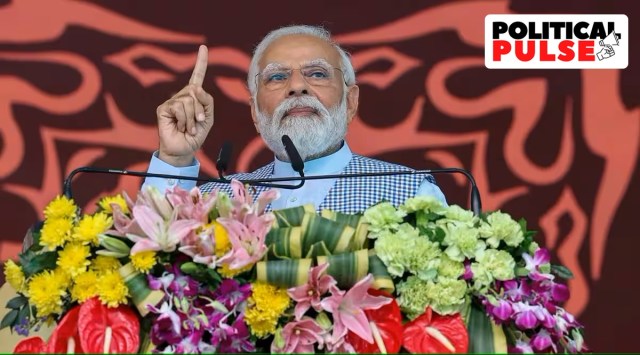PM Modi’s swipe at Cong on panchayati raj: A look back
Mahatma Gandhi saw it as an "important component" of India's future, Constitution included it in Directive Principles of State Policy, an amendment in 1992, made it a law
 Prime Minister Narendra Modi made the comments after inaugurating the 'Haryana Kshetriya Panchayati Raj Parishad'. (File Photo)
Prime Minister Narendra Modi made the comments after inaugurating the 'Haryana Kshetriya Panchayati Raj Parishad'. (File Photo) Prime Minister Narendra Modi said at an event Monday that the Congress could not understand how “important” it was to implement the panchayati raj system in villages for four decades after Independence.
“No concrete efforts were made to strengthen the Panchayati Raj institutions during the Congress rule… During the 25 years of journey of this ‘Amrit Kaal’ (2021-2046), we have to keep in mind the experiences of past decades,” he said after inaugurating the ‘Haryana Kshetriya Panchayati Raj Parishad’, a two-day BJP event, via video conference.
पंचायत व्यवस्था का लक्ष्य यही होना चाहिए कि इसका लाभ समाज की आखिरी पंक्ति में खड़े आखिरी व्यक्ति तक पहुंचे। pic.twitter.com/39yW0GDXji
— Narendra Modi (@narendramodi) August 7, 2023
Panchayati raj origins
In a 1989 paper for the Economic and Political Weekly, professor Indira Hirway wrote that the panchayati raj system was an “important component” of Mahatma Gandhi’s vision for “future India”. He is said to have “insisited” on its inclusion in the draft constitution.
The panchayati raj system found a place in the Directive Principles of State Policy — which meant it was not enforceable by courts or bound to be followed — as a mention of a two-tier form of government.
The first official state-level legislation was in Bihar in 1948.
But there was lack of a central framework, with problems such as absence of regular elections, insufficient representation of marginalised sections like the Scheduled Castes, Scheduled Tribes and women, inadequate devolution of powers (transfer from a higher level of government to the lower levels) and lack of financial resources from the state and the Centre.
Several committees were constituted for studying these issues, such as the Balwant Rai Mehta Committee (1957) and the Ashok Mehta Committee (1978).
Balwant Rai Mehta Committee
It recommended that there should be administrative decentralisation for effective implementation of development programmes, with the said system being placed under the control of local bodies.
National extension service and community development blocks were recommended to be set up with co-terminous elected panchayat samitis. Zilla parishads were also recommended to be set up as advisory bodies to panchayat samitis. Some states subsequently enacted panchayati raj legislation to give effect to the Balwant Rai Mehta Committee recommendations.
Ashok Mehta Committee
The committee viewed the panchayati raj system not only as a means of decentralisation of power and people’s participation, but also for rural development and strengthening the planning process at a micro level, Hirway noted in the EPW article.
Rajiv Gandhi government
In the late 1980s, then Prime Minister Rajiv Gandhi prioritised the issue. He gathered cross-party support and the 73rd amendment came into effect on April 24, 1993. With it being enshrined in the law and an amendment to the Constitution meant these provisions could no longer be easily ignored.
The 73rd Amendment in 1992 finally established a three-tier panchayat system with regular elections throughout India. It also mandated that “one-third of the total number of seats reserved” shall be reserved for women belonging to Scheduled Castes or, as the case may be, the Scheduled Tribes”. Additionally, it said that “no less than one-third (including the number of seats reserved for women belonging to the Scheduled Castes and the Scheduled Tribes) of the total number of seats to be filled by direct election in every panchayat shall be reserved for women and such seats may be allotted by rotation to different constituencies in a panchayat.”
Changes since
In 2009, the Constitution (110th Amendment) Bill was introduced in the Lok Sabha to increase reservation for women from one-third (33%) to one-half (50%) of the total seats in panchayats. The Bill, however, was never passed.
In 2006, Bihar became the first state to increase the reservation percentage to 50%, under CM Nitish Kumar.
Sikkim followed suit and implemented a 40% reservation policy in panchayat elections for women in 2008 (it stands at 50% now).
Chhattisgarh, Madhya Pradesh, Rajasthan and Uttarakhand subsequently passed laws to increase reservation for women in panchayats to 50%. At present, 20 states, including Madhya Pradesh, have 50% reservations for women at the panchayat level.
The Indian Express noted in its 2018 editorial, when the Act completed 25 years, “The Panchayati Raj Act not only institutionalised PRIs [Panchayati Raj Institutions] as the mandatory third tier of governance, it transformed the dynamics of rural development by giving a say to a large section of the people — significantly, women — in the administration of their localities.”
- 01
- 02
- 03
- 04
- 05






























